Answered step by step
Verified Expert Solution
Question
1 Approved Answer
After reading the article related to Managing Innovation, summarize the key points that will help you to build and sustain a culture of innovation within
After reading the article related to Managing Innovation, summarize the key points that will help you to build and sustain a culture of innovation within your group. 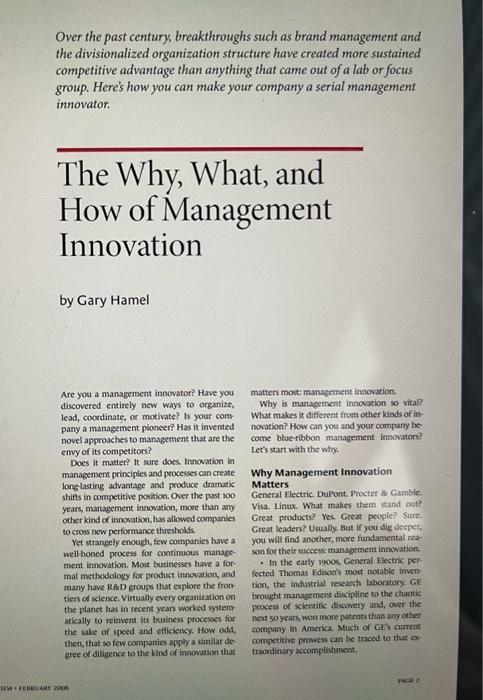
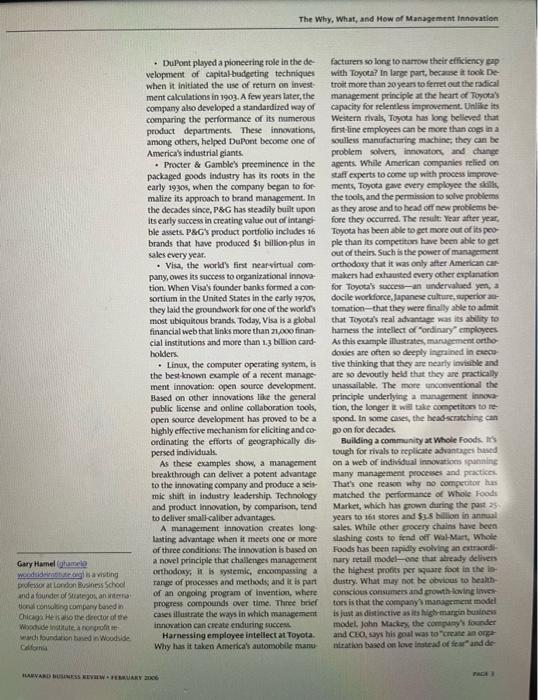
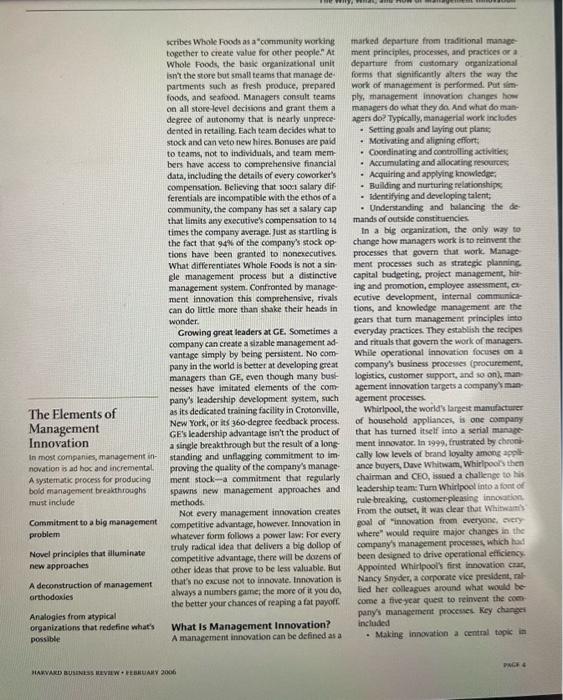
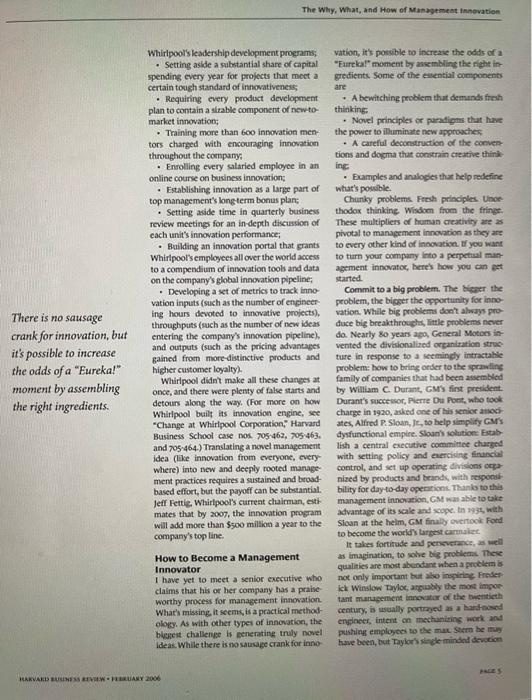
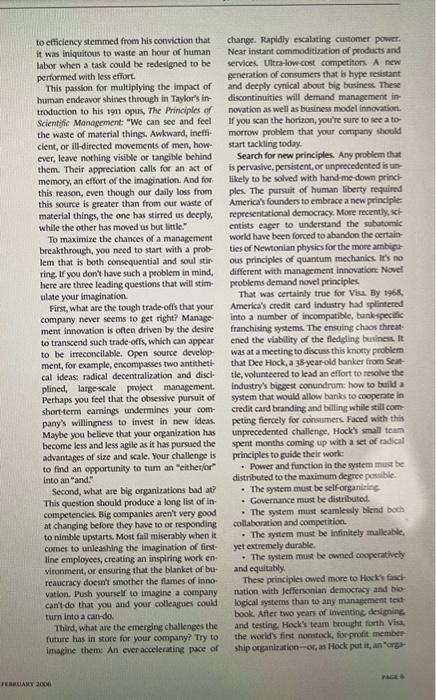

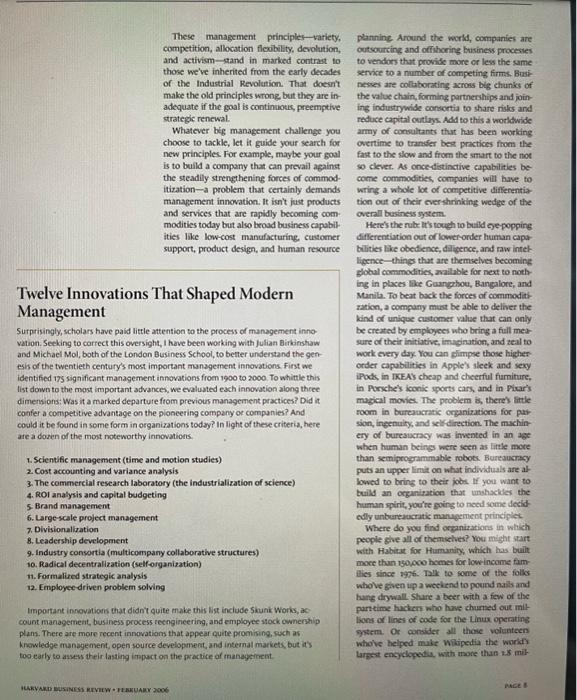

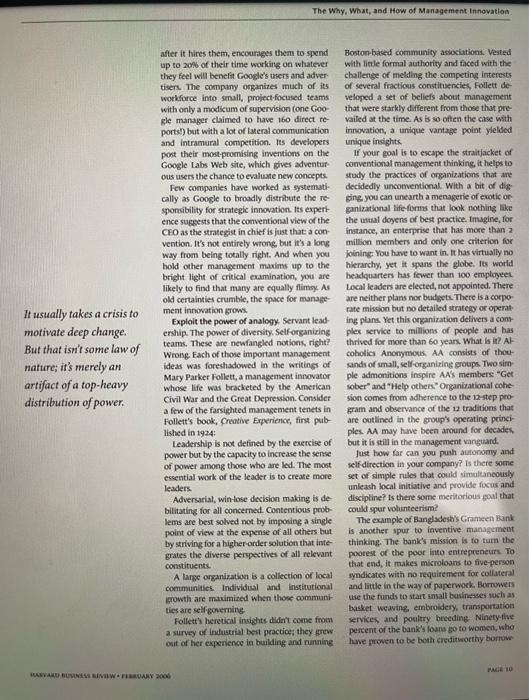

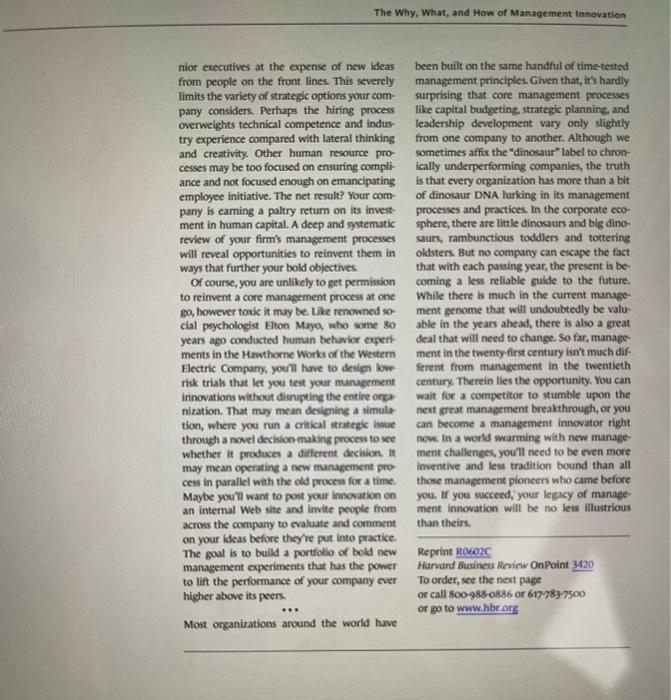
Over the past century, breakthroughs such as brand management and the divisionalized organization structure have created more sustained competitive advantage than anything that came out of a lab or focus group. Heres how you can make your company a serial management innovator. The Why, What, and How of Management Innovation by Gary Hamel Are you a management innovator? Have you matters most management innovation. discovered entirely new ways to organize, Why is management innovation so vital? lead, coordinate, or motivate? is your com- What makes it different from other kinds of inpany a management pooneer? Has it invented novation? How can you and your company benovel approaches to management that are the come blueribbon management innovatori? envy of its competitors? Does it matter? It sure does Innovation in management principles and proceses can create Why Management Innovation longlasting advantage and produce dnmatic Matters shifts in competitive position. Over the past 100 General Electric. DuPont. Procter \& Gamble. years, management innovation, more than any Visa. Linux. What makes them sand out? other kind of innovation, has allowed companies Great products? Yes Great people? Sure: Yet strangely enough, few companies have a yoa will find another, more fundamental reawellhoned process for continuous manage- son for their suceess: management innovation. mal methodology for product innovation, and fected Thomas Edison's most notable inven many have R\&D groups that explore the froo- tion, the industrial retearch liboratory. GE: tiers of science. Virtually every organization on brought management discipline to the chaotic the planet has in recent years wothed sytem- proceis of scientifie dikcovery and, over the atikally to reinvent its barines processes for neatso years woe more patents than any other the sale of speed and efficiency. How odd, company in America. Much of GEs curent. then, that so few companies apply a similar de- competitive prowers can be trieed to that exgree of diligence to the kind of innovation that troordinary aceomplishment. The Why, What, and How of Masagement Innovation - DuPont played a pioneering role in the de facturens so long to namow their cfficiency gap velopment of capleaHbudgeting techniques with Toyota? in large part, becasse it took Dewhen it initiated the use of retum on invest- troit more than 20 years to ferret out the radical ment calculations in 1903 . A few years later, the management principie at the heart of Toyoa's company also developed a standatdised way of capacity for relemeleu inprovement. Unlike its comparing the performance of its mumerons Weitern thals, Toyota has lone believed that product departments. These innovations, fint line employees can be more than cogs in a among others, helped DuPont become one of soulless manufactaritg machine, they can be Americals industrial giants. problem solven, innovatos and change - Procter \& Gamble's preeminence in the apents. While American companies relied on packaged goods industry has its rooes in the staff experts to cume pp rith process improveearly 19308 , when the company began to for- ments, Toyota gave evtry cmployee the dills malise its approach to beand mansagement. In the tools, and the permikion to solve problems the decades since, P\&GG has steadily built upon as they arose and to head off new problems be its early success in creating value out of intangh- fore they oceurred. The recalt Year after year, ble assets P\&C's product portfolio includes 16 Toyoea has been able to get more out of its peobrands that have produced \$1 billionplus in ple than its competitans have been able to get sales every year. - Vica, the world's firt nearvirtual com- orthodory that it was only atter American car pany, owes its success to organizational innova- makers had exhausted every other explanation tion. When Visa's founder banks formed a con- for Toyota's succes-an undervaluat yen, a sortium in the United States in the early 1970 , docile worlforce, Japanese culture, epperior anthey laid the groundwork for one of the worlds s tomation - that they were finally able to admit most ubiqcihous brands. Today, Visa is a global that Toyotals real advantage was its ability to financial web that links more than z,ooo finan hames the intellest of "ordinary" employees cial institutions and more than 1.3 billion cand-. As this ecample illustrates, management orthoholder. - Linux, the computer opernting sotem, is the thinking that they are nearly invtiale and the bestknown example of a recent manags are so devoutly held that they are practically ment innovation: open souroe development. unasailable. The more anconventional the fused on other innovations like the general principle underlying a management innovapublic lisense and online collaboration tools, tion, the longer it will tike competitass to re open source development has proved to be a. spond. In some cases, the beadscratching can highly effective mechanism for eliciting and co- po on for decades. ordinating the efforts of geograptically dis Building a community at whole foods. It's persed individusk. tough for rivals to replicte adrantages tused As these examples show, a management on a web of individual innovations pannine breakthrough can deliver a potent advantage many management procewes and practices. to the innowating company and prodace a seit. That's one reason why no compector has mic shift in industry leaderhip. Technology matched the performance of Whole Foodi and product innovation, by comparison, tend Market, which has fown during the pant as to deliver smallealiber advantages. years to 161 stores and 53.5 billon in annoal A management innovation creates long. sales. While cether gocery chains tave been lasting advantage when it meets one or more slathing costs to fend of wal-Murt, Whole of three conditions The innovation is bused on Foods has been rapidfy evoking an eatrachia nowel principle that challeness management rury retall model-one thut already delivers orthodoxy, it is ystemic, encompussing a the highest protiss per suare foot in the inrange of processes and methodxc and it is part dustry. What may not be coblcus to beakthGewdifoundion bared in woodide Harnessing employee intellect at Toyota. and ClO, sys his goul was to"create an orgacalionis Why has it taken America's automobile mande nization based om lore lroteal of fter" and of:- scribes Whole Foods as a community working marked departure from traditional managetopcther to create value for other people" At ment principles, processes, and practices or a Whole Foods, the basic oreanirational unit departare from customary onganizational im the store bot small teams that managede- forms that significantly alters the way the partments soch as fresh produce, prepared work of management is performed. Put limfoods, and geafood. Managers consult teams ply, management innoration changes hom on all store-level decitions and grant them a managers do what they dn And what domandegree of autonomy that is nearly unprece- agers do? Typically, managerlal work inchodes dented in retailing. Each team decides what to - Setting gaals and layirg out plant stock and can veto new hires. Bonuses are puid - Motivating and aligning effort: to tcams, not to individuals, and team mem- - Coordinating and controlling activities bers have access to comprehensive financial - Accumulating and allocating resources data, including the details of cvery coworker's - Acquiring and applyine knowledes compensation. Believing that soos salary dif- - Byllding and nurturing relationshipe. ferentials are incompatible with the ethos of a - Identifying and developing talent, community, the company has set a salary cap - Understanding and balaricine the de that limits any executive's compensation to 14 mands of outside constituencies. times the company average. Just as starting is In a big arganiration, the only way to the fact than 94\% of the company's stock op. change how managers work is to reinvent the tions have been granted to nonerecutives processes that govern that work Manage What differentiates Whole Foods is not a sin- ment processes such as strategic planning: gle management process but a distinctive capital budpeting project management, hirmanagement system. Confronted by manage- ing and promotion, employee assessment, ex: ment innovation this comprehensive, rivals ecutive development, internal commanicican do little more than shake their heads in tions, and knowledge management are the wonder. gears that turn management principles into Growing great leaders at GE. Sometimes a everyday pertices. They establish the recipes company can create a sizable management a4- and rituals that govern the work of managersvantage simply by being persistent. No com- While operational innovation focusen on a pany in the world is better at developing great company's buiness procewes (procurement, managers than GE, even though many bus- logistics, customer support, and so on), mannesses have imitated elements of the comr agement innovation targets a company'manpany's leadership development system, such agement processes. as its dedicated training facility in Crotonville, Whirlpool, the world s largeit manifactuer New York, or its 360-degree feedtack process. of household appliances, is one company GE'sleadership advantage isn't the product of that has turned itself into a serial managea single breakthrough but the result of a lons ment innovatoe, In 1999 , frustrated by checeistanding and unflagging commitment to im- cally low levels of brand loyalty among applproving the quality of the company's manage- ance beyers, Dove whitwam, Whirlpoois then ment stock-a commutment that regularly chairman and CFO, bsoed a challenge to his spawns new management approaches and leaderahip team Tum Whirlpool into a font of methods. rule bicaking, customerpleaing innonation. Not every management innovation creates From the outset, in was clear that Whithamis competitive advantage, however, Innovation in gool of "innovation from everyone, every Whatever form follows a power law: For every where" would require major changes in the trily radical idea that delivers a big dollop of company's management proceses, which bad competithe adyantage, there wil be dozens of been designed to drive operational efficiency. other Ideas that prove to be less valuable. But Appointed Whirlpooil fint innovation crat, that's no excase not to innovate. Innovation is Nancy Snyder, a corporate vice president, inl always a numbers game; the more of it you do, lied her colleagues around what woild bethe better your chances of reaping a fat poyoff. gome a frucyear quent to reiment the coenpany's management proceses. Kry charati What is Management Innovation? inchuked A management innowation can be defined as a - Making innovation a central topic in Whirlpool's lesdership development programs; vation, it's posuble to increate the odds of a - Setting aside a substantial share of capital "Eurekal" moment by assembling the right in spending every year for projects that moet a gredients. Some of the eitential components certain tough sandard of inhovativeness are - Requiring every product developenent - A bewitching peoblem that demands freak plan to contain a siable component of newe- thiaking: market innovation- - Novel principles or paradignts that have - Training more than 600 innoration men- the power to illuminate new approuches tors charged with encoumging innovation . A carefal deconatruction of the conver. throughout the company; tions and dogma that constrin creative thirk- - Enrolling every salaried employce in an ing online course on business innovation; . Eumples and analopes that help redefine - Erablishing innovation as a Large part of what's porsible. top management's longterm bonus plan; Chanky problems. Firch principles Unoe- - Setting aside time in quarterly busines thodox thinking Wisdoen from the fringe. review meeting for an in-depth discission of These multipliers of human creativity are as each unit's innovation performance; pivotal to management innovation as they are. - Building an innowation portal that grants to every other kind of innovation. If yoo want Whirlpool's employees all over the world access to turn your company into a perpetual manto a compendium of innovation tools and data agement innovatce, here's bow you can get on the company's global innovation pipeline; started. - Developing a set of metrics to track inno- Commit to a big problem. The bicer the vation inputs (such as the number of eneineer. problem, the bigger the opportunity for innoThere is no sausage Ing hours devoted to innowative projects), vation. While big problems dont always procrank for innovation, but throughputs (mach as the number of new ideas duce big breakthroeghs, litmle probicms nerver entering the company's innovation pipeline), do. Nearly so years ama, Genemal Motors init's possible to increase and outputs (such as the pricing advantages vented the divtionalired ocganitation struc: the odds of a "Eureka!" gained from moredistinctive products and ture in response to a secmingly intractahie moment by assembling once, and there were plenty of false starts and by William C. Durant, GM's first predident. the right ingredients. detours along the way. (For more on how Durant's muccensor, Pierre Du Pont, who toolt Whlrlpool built its innovation engine, see charge in 1920 , asked one of his senior ansoch"Change at Whirlpool Corporation," Harvard ates, Alfred P. Sloan, Jr, to help simplify GM's Busines School case nos, 705462, 705463 , dysfunctional empire Slounis solutione Fitaband 705 -464.) Translating a novel management . lish a central executtive commitree charged idea (GWe innovation from everyone, every- with setting policy and enerciding financial) where) into new and deeply rooted manage- control, and set up operating divisions orgament practices requires a sistained and broad- nized by products and beandy, with respondebased effort, but the payoff can be substantial. bility for dayto-day operntions. Thanks to this Jeff Fettis, Whirlpool's curreat chairman, esti management innoration, GM wat able to take mates that by 2007, the innovation program advantage of its scale and soppe. tn a934, with will add more than 5500 million a year to the Sloan at the helm, GM finally overtook ford. company's top line. to become the world's largest carmalet. How to Become a Management as inagination, to wolve liz problema. These Innovator qualities are most abunctunt when a prublem is I have yet to meet a senior executive who not only important but alko ingpiring fredetclaims that his or her company has a praise- ick Winslow Dyloc, aggeblly the mont impoeworthy process for management innovation. tant muragement imnorator of the beritieth What's missing, it seems, is a practical methot- century, is useally portroned as a barthosed ology. As with othet typet of innovation, the engincer, intent on mechaniziog work and bwerest challenge is penerating truly novel paishing emploges to the mat starn be iftay ideas. While the re is no sausage crapk for inno- have been, but Taykor s siegle minded devoion to etficiency stemmed from his conviction that change. Rapidly exalating cusomer powet. it was inlquitons to waste an hour of haman Near instant commoditization of products and Labor when a task could be redesigned to be services. Ultralow-cost competiton. A new performed with less effort. This passion for multiplying the impact of and deeply cynical about big brsiness. These buman endeavor shines through in Thylor's in- discontinuities will demand management introduction to his 1911 opus, The Principles of novation as well as busincss model innovation. Scientific Management "We can see and feel If you sean the horizon, yourte sare to see a tothe waste of material things. Awkward, ineffi- morrow problem that your company shoold cient, or ill-directed movements of men, how- start tackling today- ever, leme nothing visible or tangible behind Search for new principles. Any problem that them. Their appreciation calls for an act of is pervasive, persistent, or unprecedented is unmemory, an effort of the imagination. And for likely to be solved with hand-medown princithis reason, even though our daily loss from ples. The pursuit of human liberty required this source is greater than from our waste of America's founders to embrace a new princliple material things, the one has stirred us deeply, repecsentational democracy. More recently, sciwhille the other has moved us but lintle:" To maximize the chances of a management world have been forced to abandon the certainbreakthrough, you need to start with a prob- ties of Newtonian physies for the more ambigslem that is both comequential and soul stir ous principles of quantum mechanies lt's no ring If you don't have such a problem in mind, different with management innovation Novel here are three leading questions that will stim- problems demand novel principles ulate your imagination. That was certainly true for Visa By tobs, First, what are the tough trade offs that your America's credit card industry had splintered company never seems to get right? Manage- into a number of incompatible, bunkerpecific ment innovation is often driven by the desire franchiaing sytems. The ensuing chacs threatto transeend such trade-offs, which can appear ened the viability of the fledeling burinens it to be irreconcilable. Open source develop- was at a meeting to discuss this knoty problem ment, for example, encompasses two antitheti- that Dee Hock, a 3 syearold banker from Seatcal ideas: radical decentralization and discl- the, voluntecred to lead an effort to resolve the plined, large-seale project management. industry's bigget conundrum: how to buld a Perhaps you feel that the obsessive parsuit of system that would allow banks to coopente in shorterm eamings undermines your com- credit card branding and billing while still contpany's willingness to invest in new ideas peting fiercely for consumers. Faced with this Maybe you believe that your organization has unprecedented challenge, Hock's small tean become less and less aglle as it has pursued the spent months coming up with a set of micical advantages of size and scale. Your challenge is principles to guide their worke to find an opportunity to tum an "eithetior" . Power and function in the syntem miar be into an "and." distributed to the maximum degree porabie. Second, what are big organirations bod at? - The syntem muat be selforganieing This question should produce a long list of in. - Governance mast be distributed. competencies, Big companies aren't very good . The sytem must seamlealy Blend bech at changing before they have to or responding collaboration and comperition. to nimble tipstarts, Most fail miserably when it . The rystern must be infinitely malleable, comes to unleasing the imagination of fins- yet extremely durable. comer to unieasing the inagination of nirs- yet exircmely durabic. line employees, creating an inspiring work en- . The system must be cwned cooperatively vironment, or ensuring that the blanket of bu- and equitably. reaucracy doesn't smother the flames of inno- These peincipici owed more to Hocky fanchvation. Push yourself to imagine a company nation with jeffersonian democracy and biocantdo that you and your colleagues could logical systems than to any management teattum into a cartdo. book. After two yean of imventine designine. Thurd, what are the emerging challenges the and testing. Hock's tearn broupht fosth Vies, future has in store for your company? Try to the world's fint nonitock, forprofit member imagine them: An everaccelerating pace of ship organization-or, as Hock pot it, an "orge- nization whose product was coondination: chunge by canstantly creating new aenetic mat It'y hard to know if a management princi- terial throetgh serual recombination and mutaple is really new unless you know which ones tion. This bubbline fountain of genetic innoval are strictly vintage. Modern management tion is the key to natune's capaciry for practice is bused on a set of principles whose adsptation: The greater the diversity of the origins date back a century or more special- asne pool, the more likely it is that at least a iration, standardization, planning and con- fes ogganisens will be able to ourvive in a drotrol, hierarchy, and the primacy of extrinaic matically alicred landscape. Variety is one es rewands Generations of managers have sential principle of adaptabilitymined these principles for competitive advan: Markets too, ate adaptable Over the past so tage, and they have much to show for their ef. years, the New York Stock Exchatige has outforts. But after decades of digeing the chance performed virtually every one of its member of discovering a gleaming nugeet of new man-. companics. Competition is a halmark of both agement wisdom in these wellexplored cav markets and evolutionary biology On the erns is remote. Your challenge is to uncover NYSE, comparies compete to attrict funds, tincomventional principles that open up new and irveitors are free to place their bets as seams of management innovation. Your quest they see fit Decision making is highly distribshould begin with two simple questions tited, and investors are mosty unsentimental. What things exhibit the attributes or capabilf: As a result, markets are very efficient at realloties that yourd like to build into your organi- cutine sesources from opportunities that are zation? And what is it that imbues those ex. lees promising to thove that are more so. In emplars with their enviable qualities? moat companies, however, there are rigidities. Let's roppose your goal is to make your that tend to perpetuate historical potterns of company as nimble as change itself. You resorrce allocation. Executives, eager to deknow that in a world of accelerating change, fend their power, hoard capital and talkent even continuous strategic renewal is the only insur- when those resources could be better tased ance againt imelevance. Moreover, you real- elsenhere. Legacy programs seldom have to ite that all those management principles. compete for resources against a plethora of eryou've inherited from the Industrial Age citing alternutives. The net resalt is that contmake your company less, rather than more, panies tend to overinvelt in the pust and unadaptable. Specialization, for all its benefits, derinvet in the future. Hence, competition limits the kind of crossboundary leaming and allocation flecibility are also important dethat generates breakthrough ideas. The quest sign principles if the goal is to build a highly for greater standardiration otten leads to an adaptive organiration. unhealthy affection for conformance, the new Cormitutional democrecics rank high on any and the wacky are seen as dangeroas devia- scale of evokvability in a democracy, there is no tions from the norm. Elaborate planningand- monopoly on political action. Social campalor control systems luil executives into believing ers, interest goups, think taric, and ondinary the environment is more predictable than it citirens all have the chance to shape the legishais. A disproportionate emphasis on monetary tive agenda and influence avemment policyrewards leads managers to ditcount the Whereas change in an autocraric regime comes power of volunteerism and selfocganization in violent comvlsions, change in a democracy as mechanisms for aligning individual effort. is the prodact of many small, relutively gentle Deference to hierarehy and positional power adistinents if the goul is continuocs, traumatends to reinforce outmoded belicf sygems. free renewal, most lager corporations are still So where do you look to find the design too much like monurchies and too litile like de: principles for buildine a highly adapeabile orga- mocracies With political power concentrated nization? You look to systems that have dem- in the hasds of a few doeen serior enccutives. onstrated their adaptabitity over decades, cen- and with limke latitude for local erperimenta: turies, even acons. tion, irts no wonder that big compunies wo orten For more than 4 billion year, life has find thermolves caught behind the change cvolved at least as fast as its emvironment. curve. To reduce the coits of change in your orThar's quite a track recond. Nature inoculates ganiration, you must cmibrace the principles of itself against the risks of emironmental devoletion and activiarm. These management principles-variety, plannine Around the world, companies are competition, allocution flevibility, devolution, outsourting and ofrihoring business procestes and activism-atand in marked contrat to to vendors that prowide mone or less the same those we've inherited from the early decales service to a number of competing firms, Busf of the Industrial Revolution. That doeint nesves are collaborating across big chunks of make the old principies wrong but they are in- the value chain, forming partnerihips and joinadequate if the goal is continuous, preemptive ing industrywide consortia to share rislis and strategic renewal. reduce capital outlays. Add to this a wotldwide Whatever big management challenge you army of consultants that has been working choose to tackle, let it guide your search for overtime to transer bes practices from the new principles. For example, maybe your goal fast to the slow and from the smart to the not is to bulld a comparyy that can prevail against 50 clever. As oncedistinctive capabilities bethe steadily strengthening forees of commod- come commodities, companies will bave to itization-a problem that certainly demands wring a whole loe of competitive differentiomanapement innovation. It isnt jut products tion out of their evershriniking wedge of the and services that are mpidly betoming com- overall business system. modities today but also broad basiness capabil. Herels the sube it's tough to build ge popping itties like low-cost manufacturing, cusomer differentiation out ofloweronder human capasupport, product design, and human resource bilities like obedience, diggence, and raw intekligence-thing that are themselver becoming global commodities, awallable for next to noth Twelve Innovations That Shaped Modern ing in places like Gaanghou, Bangalore, and Manila. To beat back the forces of commoditManagement aation, a compuny munt be able to deliver the kind of unique castomer value that can only Surptisingly, scholars have paid little attention to the process of management inno-_ be created by employees who bring a full melvation. Seeking to carrect this oversight, I have been working with Julian Binkinstaw sure of their initiative, imagination, and aeal to and Michael Mol, both of the London Business School, to benter undertand the genwock every day you can glimpse those highare esis of the twentieth century's most important management innovations. First we order capabilities in Apple's sleek and sexy identifed 175 significant management innovations from 1900 to 2000 . To whimle this iPodk, in IKEAls cheap and cheerful furniture, list down to the most important advances, we evaluated each innovation along theee in Perche's iconic sorts cars, and in Picar's dimensions: Was it a marked departure from previous management practices? Did it magical movies. The peoblem is, therek little confer a competitive advantage on the pioncering company or companies? And focm in bureaccratic organizaticns for par could it be found in some form in organizations todxy? In light of these criteria, here sion, ingenuity, and self dirtction. The machinare a doten of the mont noteworthy innovations ery of bureaseracy was invented in an age when human beings were seen as little mere L Scientific management (time and motion studies) than semiprogrammable robots. Burtausracy 2. Cost accounting and variance analysis puts an upper limit on what individuals are at- 3. The commercial research laboratory (the industrialization of science) lowed to bring to their jobs If you want to 4. ROI analysis and capltal budgeting build an organigation that mohacliles the 5. Brand management human spirit, you're going to nocd some decid- 6. Large-scale project management edly unbareacratic management prinicipiec 7. Divisionalization Where do you find organizations in which 8. Leadership development people ghe all of themsches? You might start 9. Industry consortia (multicompany collaborative structures) with Habitat for Hurnanity, which has built 10. Padical decentraliration (selforganization) moce than 150 oco hemes for lowincome fam- 11. Formalired strategic analysis files since r9pti. Dalk to some of the follss 12. Employee driven problem solving whove given up a wechiend to pound nals and hang drywall-Share a beer with a fow of the Important innovations that didnt quite make this list inciude skuni Works, ac parteime hachers who hase churned out mitcount management, business process reengincering, and employee stock ownerithip . Bons or lines of code for the Linux operating plam. There are more recent innovations that appear cuite promising, sich as shtem. Or consider all those volunteen knowledge management, open source development, and internal markets, but its whove belped make wilipedia the worldy too earby to assew their lasting impoct on the mractice of manayeinent. larpent encyclopedia, with more than os init- lion articles. Each of these organizations is Empinically, these beliefs seem true enough, more of a community than a hiennehy. People but as a management innovator, you ment be are drawn to a community by a sense of shared able to distinguiah between what is apparently purpose, not by economic need. In a commu- true and what is eternally true. Yes, big chanfe nity, the opportunity to contribute isn' initiatives like GE's Six Sigma prognm bpbounded by namow job descriptions Control is ally require the support of an imparioned more peer based than boss based. Emotional CEO. Yes, right-angle thifts in strategic dires: satisfaction, rather than financial gain, drtves tion, like Kodakls embeace of all thing digital, commitment. For all those reasons, communi- are usully precipitated by an eaming meltties are amplifiers of human capability. down. And yes, just about every story of corpoWhole Foods, you will remember, long ago rate renewal is a turnaround cpic with the new embraced the notion of community as an over- CEO cast as comporate swioe. But is this the arching mansgement principle. The com- only way the world can work? Why- you shoold pany's stores, sparkling temples of gulitfree ask, does it take a crisis to provoke derp gastronorny, are about as unlike the average change? For the simple reason that in moe Kroger or Safeway as one could imagine. That's companies, a few senior enecutives have the the kind of differentiation you pet when your fint and last wond on shifts in stratepic direomanagement system encourapes team memt tion. Hence, a traditionbound management bers to bring all their wonderful human qualk- team, unwiling to surnender yedertsy certies to work-and when your competiton' tainties, can hold hostage an entire ocganira management sytems dont. tion's capacity to embrace the future. So while Deconstruct your management orthodor-. it in true that it useally thes a criais to moties. To fully appreciate the power of a new vate deep change, that isit some law of na:- If you want to build an management principle, you must loosen the ture, it's merely an artifact of a topheavy dio grip that precedent has on your imagination. trlbution of political power. organization that While some of what you believe may be icien- As a management innovatoc, you must anbunshackles the human _ tific certainty, much of it isht. Painful as it is to ject every management belief to two quesspirit, you're going to admit, a lot of what parses tor management tions fint, is the beich tancicto the alimate wisdom is unqueitioned dogma masqueradine goul you're trying to achicve? Second, can you friantgememt askem what they believe about some critical this seems a reasonable point of viens, it may management isue like change, leadenhip, or lall employees into believing that they can do employee engagenent. Once everyone's be little to influence their company's atritegic ar liefs are out on the table, identify those that rection or to rechupe its besiness model-that are held in common. (More tools for identify: they are the implementers, rather than the creing and challenging manygement orthodovies ators of strategy. Yet, if the goal is to accelerife are available at www hameltebo6,hler org) For the pace of strategic renewal or to fully eneage example, if the issue is strategic change, you the imagination and pausion of cvery emmay find that most of your colleagues believe ployec, a CEO-centric view of strategy formulathat tion is uhhelpfal at beet and dangerous at - Change must start at the topr - It takes a crisis to provoke change; Is there any reason to belisve we can chatcompany; - To lead change, you necd a very clear lot of time trying to cook op gand stratrgies agenda; Instead, it works to create an cmironment that - People are mostly against change; suwns lots of *Cooglettes" smull, grancooks - With any chanes, there will always be win- projects that may one day grow into valuable ners and losers; new products and services Gocgle looks for re- - You have to make change alfe for people; cruits who have offithe wall bobbies and an - Oreanizations can cope with only so mach corventional intrioto-pecple who aremt changer. aftald to defy conventicnal widbor-and. after it hires them, encouriges them to spend Bostonbuced community associations, Vested up to 20% of their time working on whatever with little formal authority and faced with the they feel will benefit Google's users and adver. challenge of melding the competing interests tisers. The compuny organizes much of its of several fractious constitueneies, Follett deworkforce into small, project-focused teams veloped a set of beliels about management with only a modicum of supervision (one Goo- that were starkly different from those that pregle manager claimed to have 160 direct ie vailed at the time. As is so often the case with ports!) but with a lot of lateral communication innovation, a tnique vantage point ylelded and intramural competition. Its developers unique indights post their most-promising imventions on the If your goal is to escape the stralitacket of Google Labs Web site, which gives adventur- conventional managenent thinking, it helps to ous users the chance to evaluate new concepts. sudy the practices of organizations that are Few companies have worked as systemat- decidedly uncomventional. With a bit of dis: cally as Google to broadly distibute the re- ging you can unearth a menagerie of ewotic or: sponsibility for strategic innovation. Its expert ganizational lifeform that look nothing lake ence sugeest that the conventional view of the the usual doyens of best practice. Imsgine, for CFO as the strategist in chicf is just that a con- instance, an enterprise that has more than 2 vention. It's not entirely wrong, but it's a long million members and only one criterion for way from being totally right. And when you joining You have to want in. it has virtually no hold other management maxims up to the hierarchy, yet it spans the globe. fts world bright light of critical examination, you are headquarters has fewer than 100 emplogeet. likely to find that many are equally flimsy. As Local leaden are elected, not appointed. There old certainties crumbie, the space for manage- are neither plans nor bedgets. There is a corpo- It usually takes a crisis to ment innovation grows. motivate deep change. Exploit the power of analogy. Servant lead- ing plans. Yet this organization delivers a com- ership. The power of diversity. Selforganizing pler service to millions of people and has But that isn't some law of teams. These are newfangled notions, right? thrived for more than 60 years. What is in? AtWrong. Each of those important management coholici Anonymows. AA consists of thoonature; it's merely an ideas was foreshadowed in the writings of sands of amall, self organizing groupa. Two simartifact of a top-heavy Mary Parker Follett, a management innovator ple admonitions inspire AA's members "Get arifact of a top-heavy Whose life was bracketed by the American sober" and "Help othen."Onganizational cohedistribution of power. Civil War and the Great Depression. Consider sion comes from adherence to the 12step proa few of the farsighted management tenets in . gram and observance of the 12 traditions that Follett's book, Creative Experience, firt pub- are outlined in the group's operating princilished in 1924: Leadership is not defined by the euercise of but it is still in the management vanguard. power but by the capacity to increase the sense Just how far can you puah autonomy and of power among those who are led. The most selfdirection in your company? is there some essential work of the leader is to create more: set of simple rules that could simultancously Adversarial, win-tose decision making is de diselpline? is there some meritorious goal that bilitating for all concerned. Contentious prob- could spur volunteerism? lems are best solved not by imponing a single The example of Gangladest's Crameen Bank point of view at the expense of all others but is another spur to inventive management by striving for a bigher-order solution that inte- thinking. The bank's mission is to tum the grates the diverse perpectives of all relevant pootest of the poor into entrepreneurs To constituente. that end, it makes microloans to five-person A large organization is a coliection of local syndicates with no requirement for collateral communities. Individual and institutional and litte in the way of paperwork. Bornowets growth are maximized when those communi- use the funds to start small basineses roch as lies are sellforerning . basket weaving embroldery, transpontation Folletty beretical insights didert come from services, and poultry beceding Ninery the a survey of industrial bet peactice; they grew percent of the bank's loans go to women, whe out of her expenence in builting and nunning have proven to be both creditworthy borruw - ers and astute businesppeople. Microcredit projest, the trancpurency of the process would gives these women the chance to improve radace the chance of imverment dectsions their families' wellbeing and their owa social beingowerty inftuenced by the sponsor's powier standing, As of 2004, Grameen Bank had pro- or personal persasiveness. Who would have vided funds to more than 4 million borrow . thought that bookies could inspire manapeers. Isn't it a bit odd that a desperately poor ment innovation? your challenge is to hunt woman in a developing cocantry has an easier down equally unlikely analogies that saggect time getting capital to fund an idea than a. new ways of tackling thorry, management firstevel associate in your company? if Grameen Bank can make miltions of unee cured loans to individuals who have no bank- Get the Rubber on the Road ing history, shouldn't your company be able OK, you're inspired You have some great ideas to find a way to fund the glimmerinthecye for management innovation. To turn your preprojects of ordinary employees? Now, that cedent busting theories into reality, you need would be a management innovation! to understand exactly how your compuny's exA final analogy. As Im writing this, Witliam isting management processes ecacerbate that Hill, one of the UK's leading boolmakers, is of bis problem youre hoping to solve. Start by fering odds of 3.57 "ad" on Tiger Woods in the anwering the following questions for each 2006 Masters golf toumament. That is, Woods relenant management process: is estimated to be threeand athalf more times - Who owns the proces? likely to lose than to win. The odds on Phil - Who has the power to change it? Mickekon are rather longer at 10a, while Ser- - What are its objectives? gio Garcia's chances are rated at a6i. The odds - What are the nuctess metrici? are probability estimates based on two kinds of - Who are the customers of this process? data: the expert judgment of odds compilers - Who erts to participate? and the collective opinion of sportsmad punt- - What are the data or information inputs ers laying down their bets. Having set an initial for this proces? price on a particular outcome, boolmakers as- - What analytical took are used? just the odds over time as people place addh- . What events and milestones drive this tional bets and the wisdom of the crowd be- procen? comes more apparent. - What kind of decioven does this process What's the lewon for would be management generate? innovators? Every day, companies bet millions - What are the decision-making criteria? of dollars on risky initiativese new products, - How are dechions communicated, and to new ad campaigns, new factories, big mergers whom? and so on. History sugests that many projects - How does this process link to other manwill fall to deliver their expected returns. Is agement sytems? there a way of guarding against the bubris and After documenting the details of each prooptimism that so often inflate investment ex: cess assemble a cross section of intereted parpectations? One potential solution would be to ties such as the proces owner, negular particicreate a market for judgment that hameses pants and anyone else who might have a the wisdom of a broad cross section of employ relevant polnt of view. Alk them to asess the ees to set the odds on a project's anticipated re- process in terns of its impact on the managetums. An executive sponsor would set the ink- ment challenge yourre seeking to addrecs. For tial odds for a project to achleve a particular cumple, if the goal is to accelerate your comrate of return within a specific time frame. pany's pace of terategic renewal, you may conLet's sy those odds get set at 5:1 "on, meaning cluse thar the exiting capital approval process that the sponsor believes there's a fiveto-one demunds an anreasonably bigh degree of ces chance that the project wil deliver the antici: tainty about furture retums even when the inipated retum. Employees would then be able to tial investment is very small. This frustrates the bet for or against that outcome. If marry mere - fies ible realloation of resourves to new oppor: employees bet agaime the project than for it, nanities. lou thay find thut your coupany') the sponsor would have to readjait the odds. Itratepic planning proces is eliritit in that it While a CEO could still back a lengutwe fives a doproportionate ahare af voice to ie- nior executives at the expense of new ideas been built on the same handful of timerested from people on the front lines. This severely management principles. Given that, it's hardly limits the variety of strategic options your com- surprising that core management processes pany considers. Perhaps the hiring process like capital budgeting, strategic planning, and overweights technical competence and indus leadership development vary only slightly try experience compared with lateral thinking from one company to another. Although we and creativity. Other human resource pro- sometimes affix the "dinosaur" label to chroncesses may be too focused on ensuring compli- ically underperforming companies, the truth ance and not focused enough on emancipating is that every organization has more than a bit employee initiative. The net result? Your com- of dinosaur DNA lurking in its management pany is eaming a paltry retum on its invest- processes and practices. In the corporate ecoment in human capital. A deep and systematic sphere, there are little dinosaurs and big dinoreview of your firm's management processes saurs, rambunctious toddlers and tottering will reveal opportunities to reimvent them in oldsters. But no company can escape the fact ways that further your bold objectives. that with each passing year, the present is beOf course, you are unlikely to get permission coming a less reliable guide to the future. to reinvent a core management process at one While there is much in the current managego, however toxic it may be. Like renowned so- ment genome that will undoubtedly be valucial prychologist Elon Mayo, who some 80 able in the years ahead, there is also a great years ago conducted human behavior experf- deal that will need to change. So far, managements in the Hawhorne Works of the Western ment in the twenty-first century isn' much difHectric Company, youril have to devign low ferent from management in the twentieth riak trials that let you test your management century. Therein lies the opportunity. You can irinovations without diurupting the entire orgat wait for a competitor to stumble upon the nization. That myy mean designing a simular next great management breakthrough, or you tion, where you run a critical itratege isue can become a management innovator right through a novel deciuion making process to see now in a world swarming with new managewhether it produces a different deciaion. It ment challenges, you'll need to be even more may mean operating a new management pro- inventive and less tradition bound than all cess in parallel with the old proces for a time. those management pioneers who came before Maybe you'li want to pont your innovation on you. If you succeed, your legacy of managean intemal web site and invite people from ment innovation will be no less illustrious across the company to cvaluate and comment than theirs. on your ideas before they're put into practice. The goal is to build a portolio of bold new Reprint Roearc management experiments that has the power Harvard Busineu Review OnPoint 3420 to lift the performance of your company ever To order, see the next page higher above its peers. or call 8009880886 or 6177837500 Most organizations around the world have 










Step by Step Solution
There are 3 Steps involved in it
Step: 1

Get Instant Access to Expert-Tailored Solutions
See step-by-step solutions with expert insights and AI powered tools for academic success
Step: 2

Step: 3

Ace Your Homework with AI
Get the answers you need in no time with our AI-driven, step-by-step assistance
Get Started


